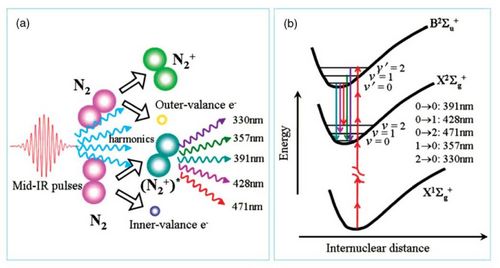Researchers at State Key Laboratory of High Field Laser Physics, Shanghai Institute of Optics and Fines Mechanics, Chinese Academy of Sciences (SIOM,CAS) demonstrate a harmonic-seeded switchable multi-wavelength laser in air driven by intense midinfrared (mid-IR) femtosecond laser pulses, in which population inversion occurs at an ultrafast time scale (i.e., less than ~200 fs) owing to direct formation of excited molecular nitrogen ions by strong-field ionization of inner-valence electrons.
They have demonstrated a remote seeded laser (not ASE) in air that can dynamically switch between different wavelengths. Unlike ASE, which depends on the fluorescence lifetime of N2- , this seeded laser propagates with the filamenting pump. Hence, lasing action (amplification of the seed) would occur as long as the filament occurs. Future development in the mid-IR ultrafast laser technology will lead to pump pulse with significantly higher energies, by which remote lasers in air with greatly enhanced peak powers and at designated remote locations can be expected. This would provide a toolkit for remote nonlinear spectroscopy applications.
This work entitled "High-brightness switchable multiwavelength remote laser in air" has been published in Physical Review A 84, 051802(R), http://pra.aps.org/abstract/PRA/v84/i5/e051802
 |
|
FIG. (Color online) (a) Interaction of nitrogen molecules simultaneously with mid-IR laser field and its third or fifth harmonics resulting in the formation of molecular nitrogen ions at an excited state by ionization of inner-valance electrons, giving rise to a harmonic-seeded laser.(b) Energy-level diagram of ionized and neutral nitrogen molecules in which the transitions between B 2_+uand X 2_+gstates are indicated with corresponding lasing wavelengths.(Image by SIOM) |